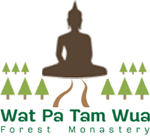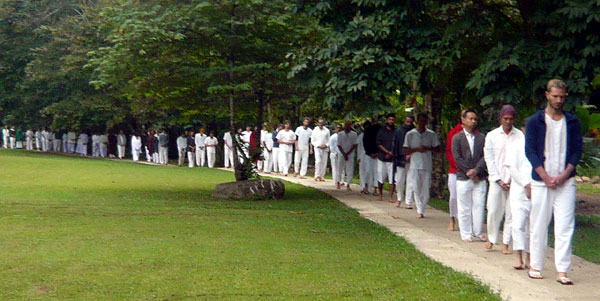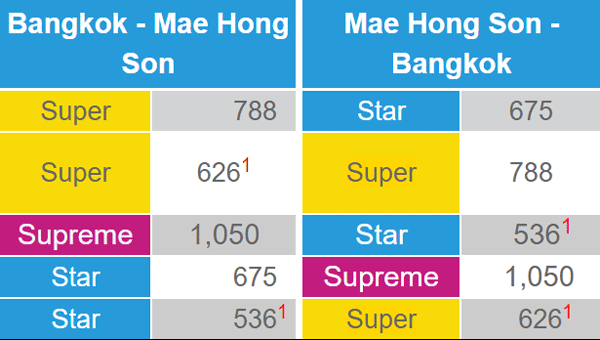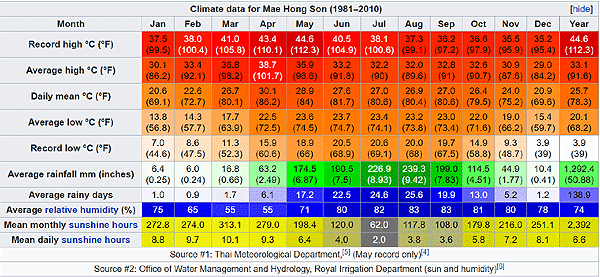 Dec 12, 2018 - Jan 1, 2019, 2018
Dec 12, 2018 - Jan 1, 2019, 2018
10-Day Meditation at Wat Pa Tam Wua Forest Monastery
Location: Wat Pa Tam Wua Forest Monastery, Mae Hong Son, Thailand
Wat Pa Tam Wua
With just a few days before my visa expiry in Vietnam, I still didn't know where to go. Nothing excited me until a passing Russian friend, Sasha, talked about Wat Pa Tam Wua meditation in the forest of Mae Hong Son, Thailand. It appealed to me. With that, the die was cast for Thailand at the Wat Pa Tam Wua Forest Monastery. That's how the universe talks to me. I'm vigilant about these signs and simply go for it when the sign becomes clear enough.
Vipassana every 6 Months
As a general rule, I do a Vipassana course once every 6 months. Meditating for 10 days brings me back on the rails, gives me a sense of bearing, calms my racing mind and reboots my entire system. My last Vipassana was still in May 2018 in Lumbini, Nepal. Sitting again is due. Meditation at Wat Pa Tam Wua is Vipassana in the Theravada Forest Monastery tradition - different from my brand and the more popular Goenka tradition. But Dhamma is dhamma - simply a different interpretation of Buddha's same words. Besides, the Goenka centers have become hugely popular that it now takes several months of advance booking to get a seat. The one in Lamphun near Chiang Mai, the earliest available retreat is already in Aug 2019!
Getting There from Bangkok
Taking the #509 bus straight to Mo Chit Bus Terminal was a breeze. On ticket counter #13, Sombat Tour, I took the 6pm bus (B675) for the 15-hour overnight bus ride to the monastery. Despite a written instruction in Thai that I showed the bus conductor to drop me off at Wat Tam Wua, and despite his nod and smile, the bus didn't stop at Wat Tam Wua. Since I had no phone to track where I was, I was completely reliant on them. I just woke up in Mae Hong Son. I went past the monastery! I had to ride a minivan going back to Chiang Mai (B100) in order to backtrack. That was a real bummer. The winding road was also nauseating. When I got off the junction, I had to rest at the corner store to get settled before I started my 1-km walk to the monastery with my 23-kg load.
Checking-In
Entering the grounds of Wat Tam Wua, it became apparent how expansive, manicured and beautiful this place is. I was ushered in by the amiable Attila, who is soon to be ordained as the first Caucasian monk at the monastery. I was provided with blanket, floor mattress, pillow, white pants/shirts and taken to my door room. There was no bed. Floor mats were there and you put your 1/2 inch mattress on it. It was spartan accommodation - as can be expected from a monastic life. I'm not looking for comfort, but with my bone structure, sleeping on a hard surface is difficult. I never got a good sleep during my entire stay (not complaining...just saying it like it is).
Daily Routine
There was a set routine for the day - 5am waking-up, food offering for the monks, breakfast, discourse/walking meditation/sitting meditation/lying down meditation, lunch, a afternoon set of discourse and meditation, break, last discourse and meditation. No dinner, but papaya is usually served in the late afternoon. We would do this repetitively for the next 10 days. I cannot imagine how the monks could sustain this daily repetition for the rest of their lives. It's ironic to think that I see them suffering from this routine as means when the reason why they do this in the first place is to rid themselves of suffering and aversion from life and rebirth.
Walking Meditation
Twice a day, we would do an hour of walking meditation. Walking barefoot gives an added layer of texture, temperature and moisture to the experience. We would walk on pavement, soil, roots, grass and some stones. If not wet, we would even walk to the forest on the foothill of the rock outcropping. To find out more about walking meditation, I even read a pamphlet and learned that many monks have attained self-realization while on walking meditation. Some monks even devote nearly the whole day and night walking. I used to think that walking meditation was only an introduction to meditation until the mind can be primed enough to appreciate the subtlety of a sitting meditation. I was wrong. Even senior and established monks make this an integral part of their practice.
Language Barrier
During the discourse, a senior monk would talk lengthily in Thai. Then a junior monk translates in English. But the 30-minute Thai talk only gets about 10 minutes of limited English translation, half of which I don't even understand. So much is lost. I feel the loss even more when I overhear some Thai meditators exclaim that the senior monk was powerful, authoritative with full conviction in his delivery. I would rather view a video file with English subtitles - that way, no information is lost. I can play-back the video, slow it down or pause it...just to ensure I get the message.

Emotional Fluctuations
Even though there is a pervading sense of tranquility within the grounds of the monastery, I would go through emotional fluctuations from day to day. One day, I could be blissed-out with everything around me to be magical. This could be followed the next day with a feeling of isolation and loneliness. The next day could be one of solid grounding and focused concentration. It was a real-world exercise in detachment and impermanence.
24/7 Meditative State
Everyday, the monks give a discourse. One said something that caught my attention. He said that with continued practice of mindfulness in everyday life, the mind gets trained to be mindful more often in the day and for longer stretches of time until it stays mindful at all times. Mindfulness 24/7? Just how powerful is that? With this newfound state, everything shifts into high gear about deepening the practice...the attainment of Samadhi at some point.
Getting more Established
I find it a little surprising that this course, being introductory, has actually taken me out of my rut. While I have done the Goenka Vipassana 9 times already, I have always felt stuck in Anapana. I can extend to awareness of body parts, but awareness of body sensation? I couldn't get there. I was essentially stuck. Being introduced to new ways of doing the same thing gave me leeway to try other approaches. What worked wonders was to read relevant materials whenever I'm free. I've read a few books while being there - walking meditation book, Arahan book, chanting book, etc. One advantage I get here is that I can read and write my reflections before the thoughts go away. Supplementing the discourse and the meditation with reading immeasurably helps. The monks cannot cover everything. Even if they can, with the language barrier, so much is lost. I've never done any reading in any Goenka course. This is probably the reason I got stuck.
Flat-Lining
With all this exercise about mindfulness in pursuit of enlightenment where you perceive reality with complete equanimity and no thought or emotion associated with it, my burning question is: Isn't that flat-lining? So what if you experience suffering and misery? Isn't that part of life? What's wrong about feeling exhilaration about a victory? or agony over a loss? Isn't that what you're supposed to experience through life as an integral part of your karmic process? Not to sound irreverent, but I don't see anything wrong with default reality. This is exactly what I've signed-up for. I've raised this question with the monk but the answer I got was not enough to change my thinking. In the here-and-now, defaulting to 'delusion' of reality is my truth (or my Bhavana Maya Panna).
Monks' Alms Round
Twice a day, breakfast and lunch, we do our food offering to the monks on their alms round. It's not really an alms round in the traditional sense. Monks live on the charity of others and rely on the food offerings by the public to sustain them. Here at the Wat Tam Wua, the alms round is more ritualistic and symbolic - we offer them food that belongs to their monastery to begin with. It's technically their food. We, the meditators, are essentially the monks because we survive on the charity of the monks - for food, lodging and Dhamma.
Ending Thoughts
I haven't completed my stay. So far, it gets better with every passing day. I'm sure there are more things to come and more to write about.
--- TheLoneRider
YOGA by Gigit ![]() |
Learn English
|
Learn English ![]() |
Travel like a Nomad
|
Travel like a Nomad ![]() |
Donation Bank
|
Donation Bank ![]()
Reader Comments:
 Kerrie Wong
Kerrie Wong(Dec 23, 2018) Oh.. you have access to writing while you are there!?
(Mar 15-16, 2018) my 10 days are up, but I offered ti develop their website, which extends my stay....until I finish it. I may have to be here until the New Year. Not a bad place to spend the holidays 🙂
Next stop: The Knower

Mae Hong Son (city), Thailand
Wat Pa Tam Wua Forest Monastery Information
Bangkok to Wat Tam Wua Forest Monastery by Bus
- go to Mo Chit Bus Terminal near Chatuchak. Bus #509, #9 and #157 go there
- at the ground level, go to Ticket Counter #13, #14 or #15 - Sombat Tour counter
- schedule and pay for your bus ticket

1 Destination/Origin: Mae Sariang. Take the bus that passes through Chiang Mai/Pai. - upon boarding, explain to the driver to drop you off Wat Tam Wua Monastery, otherwise, you might end up in Mae Hong Son town which is 30 minutes further out. Best to show him a written instruction in Thai.
- from the main road, it's a one kilometer walk to the monastery
FYI / Tips
- even though the Wat Pa Tam Wua website states that you need the abbott's permission to stay, you can just go straight there without any prior booking or registration.
- accommodation, food (no dinner), blankets, pillow, white shirts/pants and floor mattress will be provided at no charge. Donations are accepted.
- BEWARE: by the entrance to the monastic compound is a convenience store. It is not run by the monastery. The vendor offers Mae Hong Son/Pai tours without any quotation and charges exorbitant fees in the end. He also tells people that part of the fee goes to the monastery - this is not true. He has been reprimanded already but still, he continues his shady business.
- floor mattress on hard bed provides no cushioning. If this is a problem to get good sleep, you can bring an inflatable camping mattress (usually 1-inch cushioning and not too bulky to bring)
Wat Pa Tam Wua Forest Monastery Blogs
- 20 Days of Monastic Life at Wat Pa Tam Wua Dec 12, 2018 - Jan 1, 2019
- Peoplescape at the Wat Pa Tam Wua Forest Monastery Dec 12 - Jan , 2019
- Arahattamagga Arahattaphala - the path to Aranhantship Dec 30, 2018
- Goenka and the Theravada Forest Monastery Vipassana Traditions Dec 25, 2018
- The Knower Dec 24, 2018
- 10-Day Meditation at Wat Pa Tam Wua Forest Monastery Dec 12, 2018 - Jan 1, 2019, 2018
About Mae Hong Son
FYI / Tips
- Mae Hong Son Airport has flights to Chiang Mai, Bangkok, Chiang Rai, Mae Sot, Hanoi (Vietnam), Laos (Luang Prabang, Mandalay, Naypaytiaw, Vientiane) and Yangon (Myanmar)
Climate Chart

Travel Tips for Thailand
How to Get a 60-Day Thai Tourist Visa and then Extend by another 30 Days
This process is BEFORE Covid 19. Not sure what it is now.
- Bring the following to the Thai embassy:
a) proof of money (bank statement will suffice)
b) flight booking to Thailand
c) onward flight back to your country from Thailand
d) filled-in tourist visa form
e) 2 passport pictures
f) hotel booking in Thailand (they didn't ask me for this but better be safe)
g) passport with at least 6 months validity - After handing over all the documents, they will ask you to come pick your passport with the visa the following day from 4 to 5pm. That's it!
- NOTE: after 2 successful attempts, I was already questioned the 3rd time.
60-Day Thai Tourist Visa
NOTE: There is no need to go back to your country to get the Thai tourist visa. Any major city with a Thai Embassy will do. Apparently there is also no need to have an invitation from a Thai establishment to justify the visa.
- bring the following to the Immigration Office:
a) passport (make sure your Tourist Visa hasn't expired yet)
b) Baht 1900
c) photocopy of your passport + visa duration date stamp + TM6 card (white immigration card) and sign all the copies
d) completed TM7 visa extension form (available at the Immigration Office)
e) one 4cmx6cm passport picture - submit the above to the Front Desk. They will give you a stub with your number on it. Take a seat and wait for your number to be called
- when your number is called, your picture will be taken. Then go back to your seat. They will call you again.
- when they call you again, they'll give you your passport with your extended visa. That's it!
- when there are no lines, the whole process can take only 10 minutes
30-Day Extension
NOTE: When your 60-day visa is close to expiry and you want to extend your stay. No need to leave Thailand.
Book Train Tickets in Thailand
Book Train Tickets in Thailand Online by Train36.com
General Travel Tips
- arrive early - in case there is a snag (visa snag, documentation snag, transport ticket snag, etc.), you will have ample time to troubleshoot the problem if you arrive early (to the airport, to the bus terminal, etc.)
- put detailed itinerary on the Calendar apps of your smart-phone according to timelines - this is where you do all your thinking and planning. Once written down, you don't have to think anymore while you are on the journey...you just follow the steps. This frees your mind for something else that might happen while you are already en route
- avoiding scams - as a general rule, I ignore the touts or anyone I don't know who call out to me. The calling comes in many forms - "Hi! Where are you from?", "Excuse me! Excuse me!", "Where are you going?". I don't look them in the eye and I remain non-verbal with them. If you reply to them, you just gave them an 'in' to hound you. In order not to look rude, I smile and wave the 'not interested' hand to them, without looking at them.
- power bank - hand-carry your power bank. Do not check it in. You can be called in when you are already inside the plane to go all the way to the loading dock so you can personally remove the power bank...and chances are, you'll have to surrender it to them. And you might delay the plane departure!
Currency Converter
»» next Meditation story: The Knower
»» next Vipassana story: Vipassana: 6 Days of Monastic Life at Pa-Auk Forest Monastery
»» back to Meditation
»» back to Homepage
ARCHIVE 2025:
JAN |
FEB |
MAR
1970 |
1973 |
1975 |
1976 |
1977 |
1979 |
1981 |
1996 |
2000 |
2001 |
2002 |
2003 |
2004 |
2005 |
2006 |
2007 |
2008 |
2009 |
2010 |
2011 |
2012 |
2013 |
2014 |
2015 |
2016 |
2017 |
2018 |
2019 |
2020 |
2021 |
2022 |
2023 |
2024 |
2025 |
ALL BLOGS
